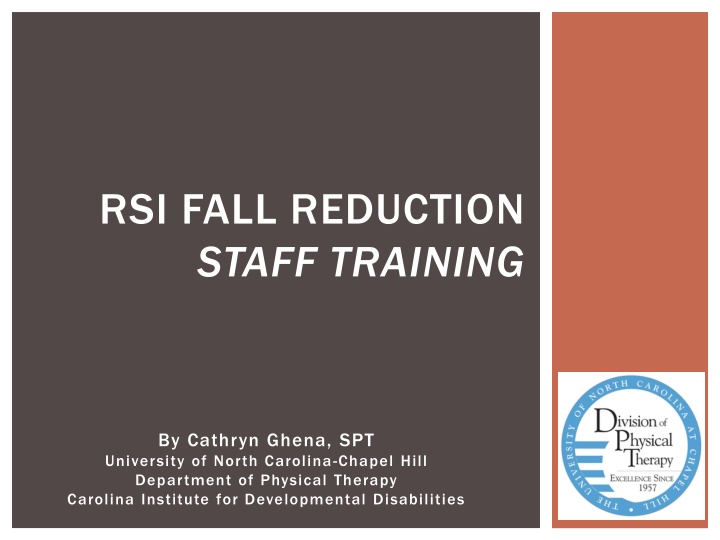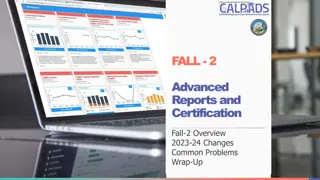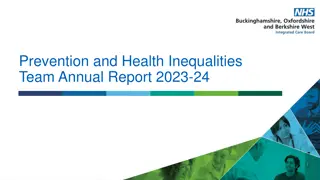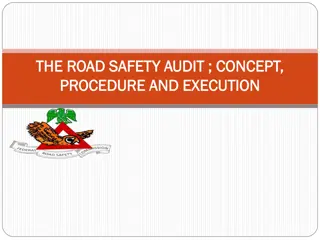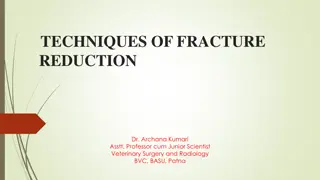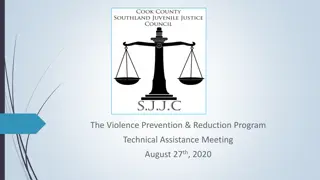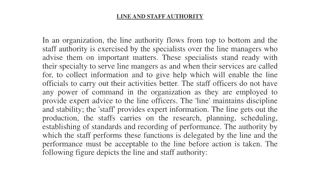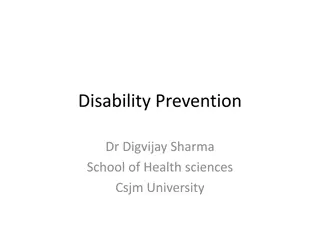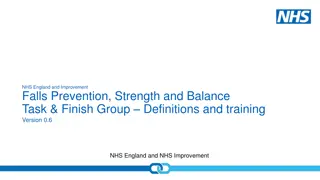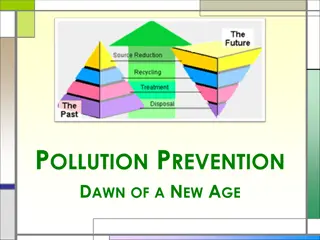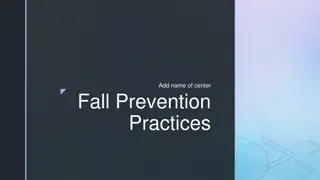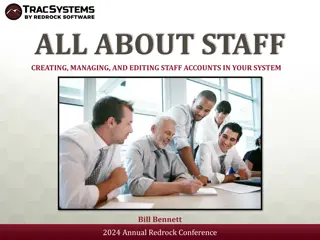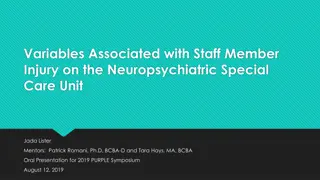RSI Fall Reduction Staff Training - Identify Causes, Risks and Prevention
In-depth training program focusing on understanding and addressing fall risks in adults, especially those with IDD. Learn about causes of falls, associated risks, prevention strategies, and the importance of physical activity. Gain insights into the Otago Exercise Program, patient exercise folders, and injury risks including hospitalization and death. Explore the impact of falls on individuals' independence, quality of life, and fear of falling again. Take proactive steps to reduce falls and improve overall well-being.
Download Presentation

Please find below an Image/Link to download the presentation.
The content on the website is provided AS IS for your information and personal use only. It may not be sold, licensed, or shared on other websites without obtaining consent from the author.If you encounter any issues during the download, it is possible that the publisher has removed the file from their server.
You are allowed to download the files provided on this website for personal or commercial use, subject to the condition that they are used lawfully. All files are the property of their respective owners.
The content on the website is provided AS IS for your information and personal use only. It may not be sold, licensed, or shared on other websites without obtaining consent from the author.
E N D
Presentation Transcript
RSI FALL REDUCTION STAFF TRAINING By Cathryn Ghena, SPT University of North Carolina-Chapel Hill Department of Physical Therapy Carolina Institute for Developmental Disabilities
OBJECTIVES Display ability to answer the following questions about falls falls: What CAUSES CAUSES a client to fall? What are the RISKS RISKS associated with falling? How can we PREVENT PREVENT a fall from happening? Display understanding of Otago Exercise Program protocol protocol Demonstrate all exercises including ability to recognize common errors recognize common errors exercises of the Otago Exercise Program, Display understanding of how/when to use patient exercise folder exercise folder patient
THE NUMBERS 30% 30% of adults >65y.o. fall annually1 50% 50% of adults >80y.o. fall annually1 67% 67% of adults who fall, will fall AGAIN within 6 months1 Every year, ~2 million 2 million adults go to the hospital after a fall1 Every 29 29 minutes, an elderly adult dies because of a fall2 Adults with IDD experience 35 peers3 35- -55% 55% more falls than their
Weakness Balance Unsteady gait Seizures Low blood pressure Seizures WHAT CAUSES A FALL? Wet floors Tripping Pushing Agitation Inattention 3, 4, 5, 6
PHYSICAL INACTIVITY TRENDS Adults with IDD are less likely to be active. activity = fall risk 7
Injury Hospital WHAT ARE THE RISKS? Death Fear
RISKS INJURIES INJURIES: 50-60% of injuries in adults with IDD3, 8 1.7-3.3x more likely to fracture a bone 9 95% of hip fractures1 1 out of 5 injuries result in head trauma or brain injury1 HOSPITALIZATION HOSPITALIZATION: $55 billion annual costs are secondary to falls2 DEATH DEATH: Decreased independence increases risk of early death10 21,000 older adults die from accidental falls1 Every 29min, an older adults dies from a complication related to falls2 FEAR FEAR: Fall occurs fear of falling again limits activity decrease strength/balance greater risk of falling 2-3x more likely to fall again1
STRATEGIES TO LIMIT FALLS Physical Environment Health Social Monitor medications Strengthen Night lights Resident bonding Calcium/Vitamin D supplements Non-skid socks/shoes Separate multiple agitated clients Balance training Bed alarms Control BP Separate those who often fight Assistive devices Address seizures Rearrange furniture Grab bars/railings Regular toileting Carpeting Remove throw rugs
SPRING GLEN 15 residents Average age: 63 years old. Diagnoses: seizure disorder, cerebral palsy, Down syndrome, anxiety, depression, incontinence, vision loss, obesity 13 falls in 8 months Injuries: broke ribs, punctured lungs, broken arm, stitches
STAFF ROLE INCREASES DECREASES - Physical activity - Motivation - Participation - Number of falls 11, 12
What is it? THE MODIFIED OTAGO EXERCISE PROGRAM 13
OEP OVERVIEW One year exercise program Warm up Strengthening Balance Walking WARM UP BALANCE WALKING STRENGTH
TIMELINE 8 mos. 8 mos. re re- - assess assess- - ment ment 12 mos. 12 mos. final final assess assess- - ment ment Initial Initial assess assess- - ment ment Start Start exercise exercise program program Develop Develop client client programs programs 6 mos. 6 mos. re re- - assessm assessm ent ent 10 mos 10 mos. . reassess reassess - -ment ment
THE EXERCISES WARM UP STRENGTH BALANCE WALKING
IS THERE ENOUGH TIME???
WE ARE HERE TO HELP YOU AND THE CLIENT.
REFERENCES 1. Falls among older adults: An overview. Centers for Disease Control and Prevention Web site. http://www.cdc.gov/HomeandRecreationalSafety/Falls/adultfalls.html . Published 2013. Updated 2013. Accessed March 3, 2014. 2. Cost of fall injuries in older persons in the united states. Centers for Disease Control and Prevention Web site. http://www.cdc.gov/homeandrecreationalsafety/Falls/data/cost-estimates.html. Published September 26, 2011. Updated 2011. Accessed May, 2014. 3. Smulders E, Enkelaar L, Weerdesteyn V, Geurts AC, van Schrojenstein Lantman-de Valk H. Falls in older persons with intellectual disabilities: Fall rate, circumstances and consequences. J Intellect Disabil Res. 2013;57(12):1173-1182. doi: 10.1111/j.1365-2788.2012.01643.x; 10.1111/j.1365- 2788.2012.01643.x. 4. Hale L, Bray A, Littmann A. Assessing the balance capabilities of people with profound intellectual disabilities who have experienced a fall. Journal of Intellectual Disability Research. 2007;51(4):260- 268. doi: 10.1111/j.1365-2788.2006.00873.x. 5. Cox CR, Clemson L, Stancliffe RJ, Durvasula S, Sherrington C. Incidence of and risk factors for falls among adults with an intellectual disability. J Intellect Disabil Res. 2010;54(12):1045-1057. doi: 10.1111/j.1365-2788.2010.01333.x; 10.1111/j.1365-2788.2010.01333.x. 6. Ollendick, K.; Wilfley, L.; Noonan, C.; Scales, M; Scow, S.; Brown, L. Identification of Incidence, Risk Factors, and Causes of Falls in Individuals with Intellectual and Developmental Disabilities. Division of Physical Therapy and Carolina Institute for Developmental Disabilities, University of North Carolina - Chapel Hill. Poster Presentation at: Combined Sections Meeting of the American Physical Therapy Association; February 4, 2014; Las Vegas, Nevada.
REFERENCES (CONT 7. Vital signs: Adults with disabilities. Centers for Disease Control and Prevention Web site. http://www.cdc.gov/vitalsigns/disabilities/index.html?s_cid=cdc_homepage_whatsnew_002 . Published May 2014. Updated 2014. Accessed May, 2014. 8. Finlayson J, Morrison J, Jackson A, Mantry D, Cooper SA. Injuries, falls and accidents among adults with intellectual disabilities. prospective cohort study. J Intellect Disabil Res. 2010;54(11):966-980. doi: 10.1111/j.1365-2788.2010.01319.x; 10.1111/j.1365-2788.2010.01319.x. 9. Browner WS, Pressman AR, Nevitt MC, Cummings SR. Mortality following fractures in older women. the study of osteoporotic fractures. Arch Intern Med. 1996;156(14):1521-1525. 10. Thomas S, Mackintosh S, Halbert J. Does the 'otago exercise programme' reduce mortality and falls in older adults?: A systematic review and meta-analysis. Age Ageing. 2010;39(6):681-687. doi: 10.1093/ageing/afq102; 10.1093/ageing/afq102. 11. Bonner A, MacCulloch P, Gardner T, Chase CW. A student-led demonstration project on fall prevention in a long-term care facility. Geriatr Nurs. 2007;28(5):312-318. doi: 10.1016/j.gerinurse.2007.04.014. 12. Podgorski CA, Kessler K, Cacia B, Peterson DR, Henderson CM. Physical activity intervention for older adults with intellectual disability: Report on a pilot project. Ment Retard. 2004;42(4):272-283. doi: 2. 13. Tools to implement the otago exercise program: A program to reduce falls. In: First ed. Center for Disease Control and Prevention.
